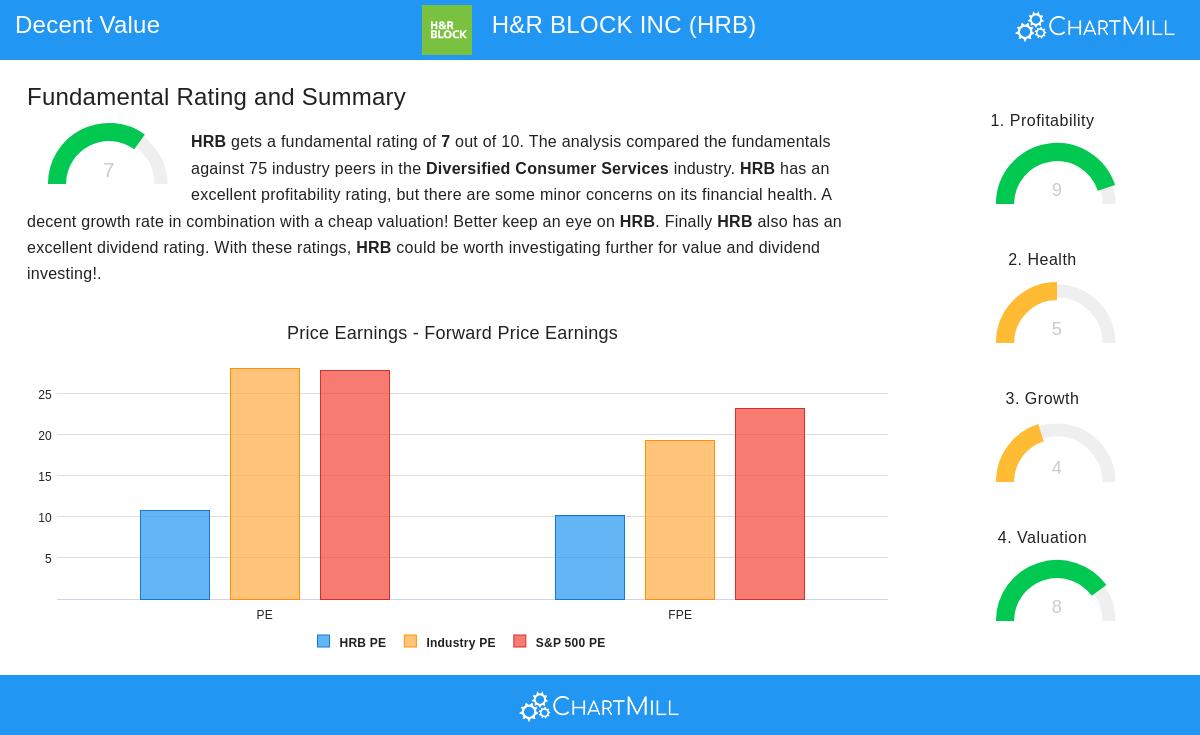H&R BLOCK INC (NYSE:HRB) Presents a Compelling Case for Value Investors
By Mill Chart
Last update: Oct 2, 2025
H&R BLOCK INC (NYSE:HRB) presents an interesting case study for investors using value investing principles. This established investment method, created by Benjamin Graham and later developed by Warren Buffett, centers on finding companies trading for less than their intrinsic value. The strategy looks for securities where the market price does not completely represent the company's fundamental worth, creating possible chances for investors who can see this difference. Value investors usually search for businesses with good financial bases that are temporarily unpopular or not noticed by the market.

Valuation Metrics
The tax preparation company is notable for its appealing valuation metrics, which are the foundation of value investing analysis. The company's current valuation ratios indicate the stock could be trading for less than its actual value.
- Price-to-Earnings ratio of 10.76, much lower than the industry average of 28.11
- Forward P/E ratio of 10.23, compared to the industry average of 19.30
- Enterprise Value to EBITDA ratio ranking more inexpensive than 83% of industry peers
- Price-to-Free Cash Flow ratio more appealing than 89% of competitors
These valuation metrics are especially noteworthy when viewed next to the company's profitability. Value investors look for this kind of difference, where solid earnings power is not completely represented in the stock price. The company's sensible valuation offers what Graham named a "margin of safety," guarding investors against possible errors in intrinsic value estimates.
Profitability Strength
The company shows very good profitability metrics, a key element for value investors who favor lasting business models over speculative growth narratives. Good profitability shows a company's capacity to produce steady returns, which in the end pushes long-term shareholder value.
- Return on Invested Capital of 32.95%, doing better than 99% of industry peers
- Return on Assets of 18.40% ranks with the best performers in the sector
- Operating Margin of 22.01% is higher than 87% of competitors
- Steady positive earnings and cash flow generation over the last five years
These profitability measures are important for value investors because they show efficient use of capital and lasting competitive benefits. Companies with high returns on capital can reinvest earnings at good rates, increasing shareholder wealth over time, a central idea in value investing methodology.
Financial Health Assessment
The company's financial health shows a varied picture with both positive aspects and points for observation. While some solvency metrics seem solid, liquidity measures deserve notice from possible investors.
- Altman-Z score of 3.24 shows low bankruptcy risk
- Debt to Free Cash Flow ratio of 2.49 implies manageable debt levels
- Lower debt-to-assets ratio compared to the prior year
- Current Ratio of 0.90 is below industry standards
Value investors thoroughly evaluate financial health to avoid "value traps," companies that seem inexpensive but have underlying financial pressure. The company's good solvency metrics are positive, though the weaker liquidity ratios should be thought about when creating a margin of safety for investment choices.
Growth Trajectory
The growth profile mixes strong historical earnings increase with more moderate revenue forecasts, forming a notable situation for value-focused investors.
- Historical EPS growth of 43.89% each year over recent years
- Expected future EPS growth of 12.47% per year
- Revenue growth forecast at 3.32% annually
- Dividend growth rate of 6.79% over time
For value investors, maintainable growth is better than rapid but possibly unsteady expansion. The company's anticipated earnings growth, together with its dividend history, indicates a business that can provide steady returns without depending on too much optimism already included in the stock price.
Dividend Appeal
The company's dividend features match well with value investing principles, providing income while investors wait for the market to acknowledge the company's total value.
- Dividend yield of 3.40% is higher than industry and S&P 500 averages
- Ten-year history of dependable and increasing dividend payments
- Maintainable payout ratio of 32.86% of earnings
- Dividend growth that is greater than earnings growth
Income creation is a significant part of total returns in value investing, offering payment during times when market feeling does not show business basics. The company's dividend dependability and growth history improve its attractiveness to patient investors.
The complete fundamental analysis report offers more detail on these metrics and what they mean for investment consideration.
For investors looking for similar chances, other companies meeting value investment criteria can be located using our Decent Value Stocks screening tool.
Disclaimer: This analysis is for informational purposes only and does not constitute investment advice, recommendation, or endorsement of any security. Investors should conduct their own research and consult with financial advisors before making investment decisions. Past performance does not guarantee future results.
43.71
+0.43 (+0.99%)
Find more stocks in the Stock Screener
HRB Latest News and Analysis





